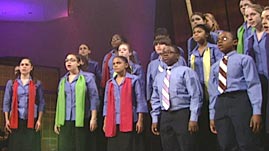Teachers' Domain - Digital Media for the Classroom and Professional Development
User: Preview


Source: From the Top at Carnegie Hall: "Singing, Strumming, Skating"
You can see the full episode and a more complete lesson plan at the From the Top at Carnegie Hall Web site.



Exclusive corporate funding provided by Liberty Mutual. Additional funding provided by the Bernard Osher Foundation, the Jack Kent Cooke Foundation, the National Endowment for the Arts, Helen and Peter Bing, and the E.H.A. Foundation.
The Young People's Chorus was founded by conductor Francisco Nuñez to celebrate the diversity and musical richness of his hometown, New York City. In this performance video from From the Top at Carnegie Hall, listen to a performance of Panta Rhei (Greek for "all things are in flux") by another New Yorker, composer Jim Papoulis. Many of the musical elements—a driving rhythm, syncopation, atonality, and surprising percussion—contribute to the sense of change and movement.
The Young People's Chorus (YPC) was founded by Francisco Nuñez to reach into New York City neighborhoods and include children of diverse economic, religious, and ethnic backgrounds. This award-winning ensemble is committed to musical excellence, has performed throughout the world, and is known for commissioning original works such as Panta Rhei from renowned artists. More than fifty choral works have been produced for YPC since 2001.
New York-based composer Jim Papoulis is a frequent collaborator with the chorus. A versatile and successful artist, he creates music for films, dance, ensembles, and solo performers, including Aretha Franklin, Christina Aguilera, and Shania Twain. He also established the Foundation for Small Voices, which works with children worldwide to create and present music that bridges "cross-cultural, generational, and ideological boundaries."
Here is what the composer says about Panta Rhei:1
The text of Panta Rhei combines a few phrases and words in Greek that speak to qualities exemplifying inner strength. The translation of Panta Rhei is All things are in flux, and through it I explore the rhythms, patterns, and cycles of life. The rhythms and vocal patterns are varied, as life is; the structure is as traditional as the cycles of life, with a strong female presence defining it. It is no coincidence that this piece is written for the female voice; I have been fortunate to be surrounded by many strong women throughout my life. My mother remains a major influence on the way I look at the world; my four sisters taught me the importance of remembering that women are first and foremost human beings who see the world with compassion, as do my own two daughters.
Here is a translation of the Greek terms in the text:
1Panta Rhei program notes as provided to the Young People's Chorus for www.ypc.org. Reprinted courtesy of Jim Papoulis.
 Loading Standards
Loading Standards